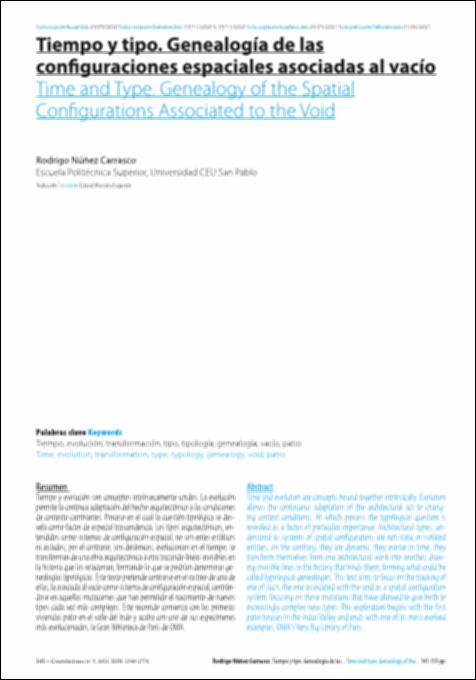Please use this identifier to cite or link to this item:
http://hdl.handle.net/10637/12955Tiempo y tipo: genealogía de las configuraciones espaciales asociadas al vacío.
| Title: | Tiempo y tipo: genealogía de las configuraciones espaciales asociadas al vacío. Time and Type: Genealogy of the Spatial Configurations Associated to the Void |
| Authors : | Núñez Carrasco, Rodrigo Massana Esquerdo, Eduard |
| Keywords: | Tiempo.; Evolución.; Transformación.; Tipo.; Tipología.; Genealogía.; Vacío.; Patio.; Time.; Evolution.; Transformation.; Type.; Typology.; Genealogy.; Void.; Patio. |
| Abstract: | Tiempo y evolución son conceptos intrínsecamente unidos. La evolución
permite la continua adaptación del hecho arquitectónico a las condiciones
de contexto cambiantes. Proceso en el cual la cuestión tipológica se desvela como factor de especial trascendencia. Los tipos arquitectónicos, entendidos como sistemas de configuración espacial, no son entes estáticos
ni aislados; por el contrario, son dinámicos, evolucionan en el tiempo, se
transforman de una obra arquitectónica a otra trazando líneas invisibles en
la historia que los relacionan, formando lo que se podrían denominar genealogías tipológicas. Este texto pretende centrarse en el rastreo de una de
ellas, la asociada al vacío como sistema de configuración espacial, centrándose en aquellas mutaciones que han permitido el nacimiento de nuevos
tipos cada vez más complejos. Este recorrido comienza con las primeras
viviendas patio en el valle del Indo y acaba con uno de sus especímenes
más evolucionados, la Gran Biblioteca de París de OMA. Time and evolution are concepts bound together intrinsically. Evolution allows the continuous adaptation of the architectural act to changing context conditions. At which process the typological question is revealed as a factor of particular importance. Architectural types, understood as systems of spatial configuration, are not static or isolated entities; on the contrary, they are dynamic, they evolve in time, they transform themselves from one architectural work into another, drawing invisible lines in the history that binds them, forming what could be called typological genealogies. This text aims to focus on the tracking of one of such, the one associated with the void as a spatial configuration system, focusing on those mutations that have allowed to give birth to increasingly complex new types. This exploration begins with the first patio houses in the Indus Valley and ends with one of its most evolved examples, OMA's Very Big Library of Paris.. |
| Description: | En: Constelaciones. ISSN. 2340-177X. n. 9, 2021, pp 141-155 |
| URI: | http://hdl.handle.net/10637/12955 |
| Rights : | http://creativecommons.org/licenses/by-nc-nd/4.0/deed.es |
| Issue Date: | 25-Jun-2021 |
| Appears in Collections: | Núm. 9 (2021) |
Items in DSpace are protected by copyright, with all rights reserved, unless otherwise indicated.


